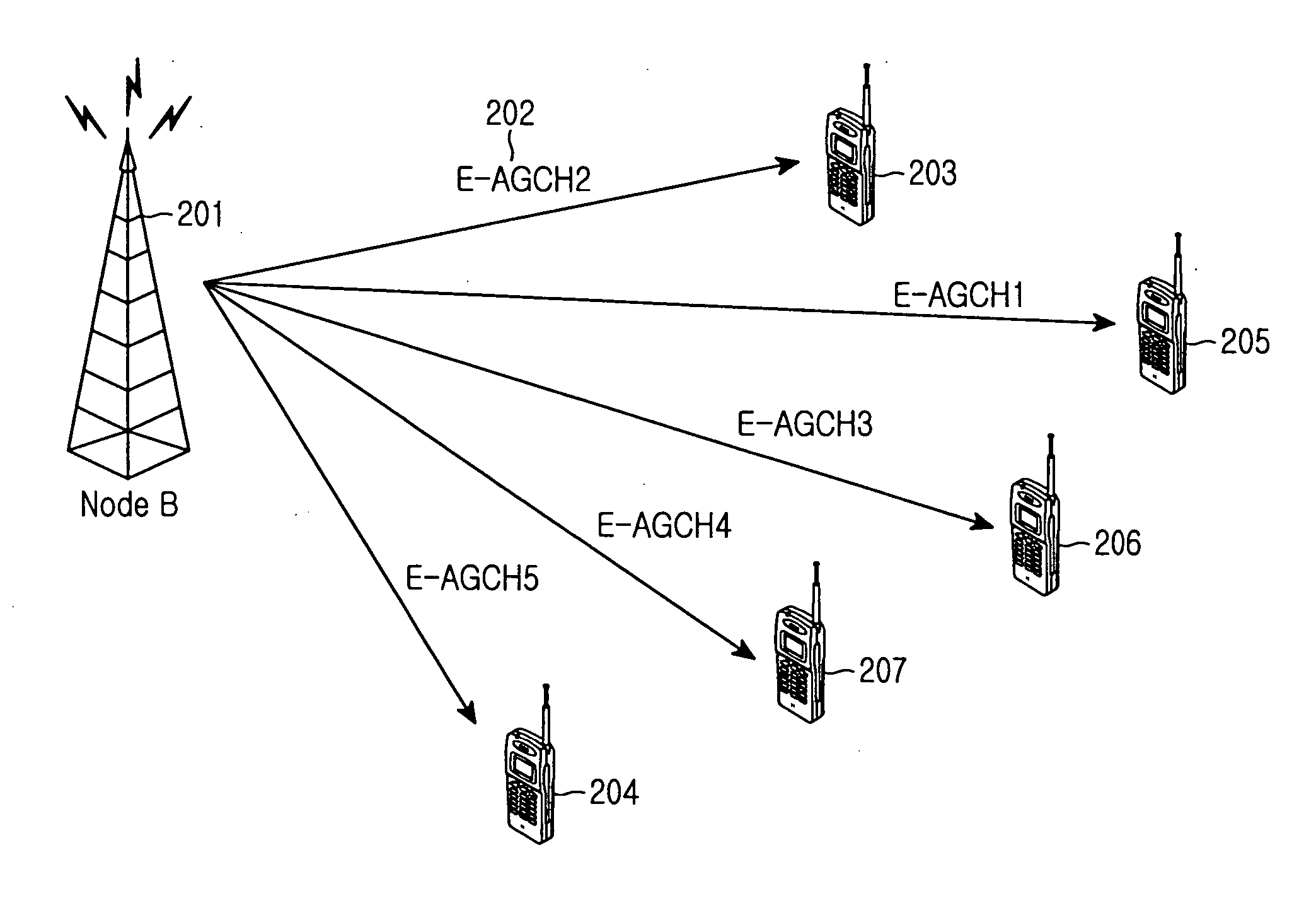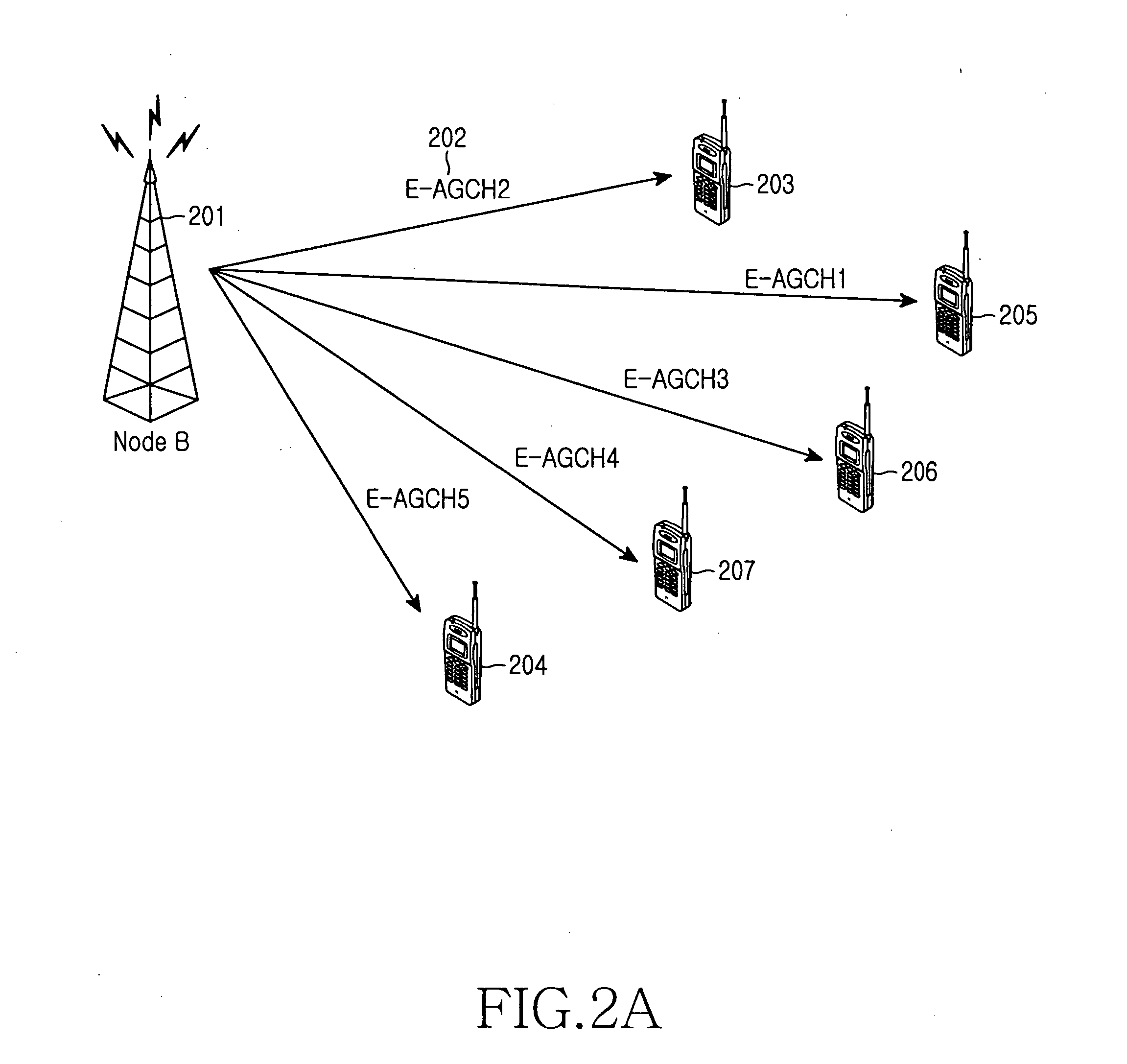Method and apparatus for scheduling uplink data transmission using UE-ID in a mobile communication system supporting uplink packet data service
a mobile communication system and packet data technology, applied in the field of mobile communication systems supporting uplink packet data services, can solve the problems of affecting the reception performance of a node b, so as to minimize the overhead of signaling
- Summary
- Abstract
- Description
- Claims
- Application Information
AI Technical Summary
Benefits of technology
Problems solved by technology
Method used
Image
Examples
first embodiment
[0059] In a system where the uplink data rates of UEs are controlled by AGs, a radio network controller (RNC) allocates a common UE-ID and a dedicated UE-ID to each UE and a Node B transmits an AG to the UE by the common or dedicated UE-ID.
[0060]FIG. 3 illustrates the data format of an E-AGCH for carrying an AG according to an embodiment of the present invention.
[0061] Referring to FIG. 3, an AG 302 indicates the absolute value of an allocated allowed maximum data rate and a CRC field 304 provides a CRC masked with a UE-ID. Since the CRC 304 is masked with a specific UE-ID, the AG 302 is decoded only by a UE having the UE-ID and neglected by a UE with a different UE-ID due to CRC error. Alternatively, the UE-ID may be substituted for the CRC 304.
[0062] The E-AGCH can be configured in two ways to deliver an AG to a UE. The E-AGCH is configured in the above manner, that is, using a CRC masked with a UE-ID. Thus, the UE performs a CRC check using the CRC. Alternatively, the E-AGCH i...
second embodiment
[0084] In a system where the uplink data rates of UEs are controlled by RGs indicating UP, DOWN or KEEP, an RNC allocates common codes and dedicated codes to the UEs and a Node B transmits the RGs to the UEs by the dedicated or common codes.
[0085] The RNC sets both common and dedicated codes for UEs by upper layer signaling in allocating orthogonal codes to the UEs, for RG reception. Here, the RNC sets one common code for all UEs in each cell or for a UE group classified by service type. The UEs basically have dedicated codes. UEs that report similar status information, have the same QoS, or have the same service type can be grouped into one UE group.
[0086] In every scheduling period, the Node B determines RGs and signaling schemes for UEs that are communicating for an E-DCH service. The signaling schemes are decided depending on system design and implementation. The Node B selects common signaling for most RGs indicating UP, DOWN or KEEP in one embodiment. In another embodiment, ...
third embodiment
[0097] A third embodiment of the present invention is characterized by the use of an indicator indicating a scheduling grant or common control information so that a UE operating in accordance with the first embodiment of the present invention does not need to distinguish the scheduling grant from the common control information by performing a CRC check on an E-SGCH designed for delivering a scheduling grant.
[0098] In the first embodiment of the present invention, the UE uses numerous UE-IDs including dedicated and common UE-IDs in CRC checks. This may bring about reception complexity to the UE which must read a scheduling grant in every TTI. To overcome the shortcoming, an indicator indicating a scheduling grant or common control information is inserted into the header of E-SGCH data, thereby mitigating the CRC check constraint in the third embodiment of the present invention.
[0099] With reference to FIG. 10, the structure of E-SGCH data according to the third embodiment of the pr...
PUM
 Login to View More
Login to View More Abstract
Description
Claims
Application Information
 Login to View More
Login to View More - R&D
- Intellectual Property
- Life Sciences
- Materials
- Tech Scout
- Unparalleled Data Quality
- Higher Quality Content
- 60% Fewer Hallucinations
Browse by: Latest US Patents, China's latest patents, Technical Efficacy Thesaurus, Application Domain, Technology Topic, Popular Technical Reports.
© 2025 PatSnap. All rights reserved.Legal|Privacy policy|Modern Slavery Act Transparency Statement|Sitemap|About US| Contact US: help@patsnap.com



